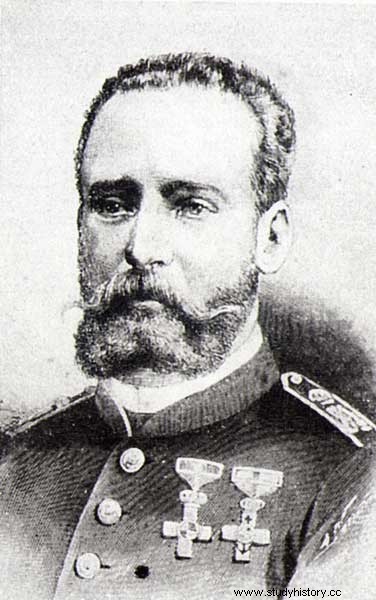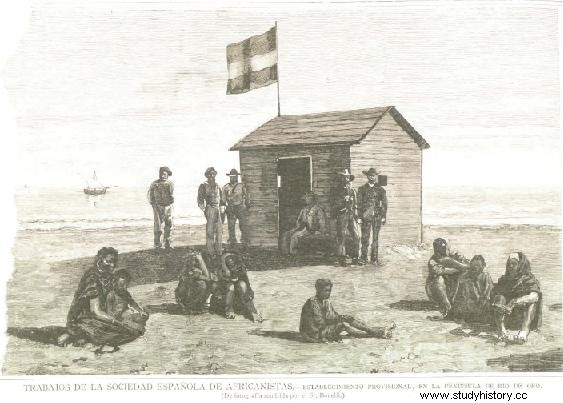We already talked about how Spain left the Sahara (History of a moral debt with the Saharawi people)…
Spain abandoned the Saharawi people to their fate. They passed from Spanish rule to Moroccan military occupation.
Today we are going to talk about how we got there… This is the story of how Emilio Bonelli managed to occupy Western Sahara with 7,500 pesetas (45 euros) .

Emilio Bonelli
Eduardo Bonelli, an Italian agricultural engineer, settled in Zaragoza where he met Isabel Hernando. The protagonist of our story would be born there in 1855... Emilio Bonelli . After his wife died, Eduardo and his son began a journey that took them to Marseille, Algiers, Tunis and Tangier. This journey helped little Emilio to speak perfectly Spanish, Italian, French and Arabic. In 1869, when he was just 14 years old, his father died of cholera and Emilio had to fend for himself. Thanks to the different languages he spoke, he got a job as a translator at the Spanish Consulate in Rabat with a salary of 50 pesetas a month. At the age of 20 he was called up and decided to enter the Toledo Infantry Academy, which he could afford with translations and with the help of his companions. In 1878 he graduated as an ensign and was posted to the 4th Princess Regiment based in Madrid. In addition to his military obligations, he also had time to put the accounts of the Madrid City Council in order, for which he received compensation of 3,000 pesetas. He requested a leave of absence and used the money to travel around Morocco as a civilian:Tangier, Rabat, the Sebu river basin, Garb, Fez and Mequinez (Meknes).
Upon his return in 1882, he gave a lecture at the Geographical Society of Madrid about his trip, in which his commitment to the colonization of Morocco could be glimpsed. Taking advantage of the fact that several Canarian fishing boats had been attacked near the Moroccan coast, he presented a project to the Minister of War, Genaro Quesada Mathews , to occupy the coast - which at that time was beyond the reach of the sultan of Morocco - and protect the fishermen, but his proposal was rejected by the Minister. As a good man –stubborn where they come – He did not give up, he went directly to the Buenavista Palace to present his idea to the President of the Council of Ministers Cánovas del Castillo . He was delighted with the proposal and in order not to have problems with the rest of his cabinet, nor undermine the authority of Genaro Quesada, he decided to finance the adventure with 7,500 pesetas of the reserved funds of the time (at the disposal of the President and without the need for justification).
In 1884, Emilio Bonelli -«alone and equipped only with a djellaba, slippers, a backpack, a teapot and a kifi pipe «-, left for Tenerife. There, as a businessman, he rented the sailboat Ceres and he left for the area with a group of Spanish explorers. On November 4, without any military support, the group landed on the coast, built a booth and raised the Spanish flag in what would later become Villa Cisneros, the capital.

For almost two months, Emilio and his group raised the flag at various other points (Puerto Badía, Puerto Gatell…). In addition, using his perfect knowledge of Arabic, he established several treaties with the tribes of the area, taking possession of a territory between Cabo Bojador to the north and Cabo Blanco to the south. For once in the history of Spain he acted quickly and, taking advantage of the Berlin Conference , held between November 15, 1884 and February 26, 1885, in which the colonial expansion in Africa was proposed -«the literal division of Africa «-, the fait accompli was made known to the colonial powers and the Declaration of the Spanish Protectorate of Western Sahara was presented. with the limitations established to the north and south by the capes and towards the interior of the continent until finding another colonial power. Without a single shot and with 7,500 pesetas, which was used to pay for the trip and buy the odd will, Spain took over Western Sahara.
Sources:Royal Geographical Society, Emilio Bonelli, Secret Explorations in Africa – Fernando Ballano
